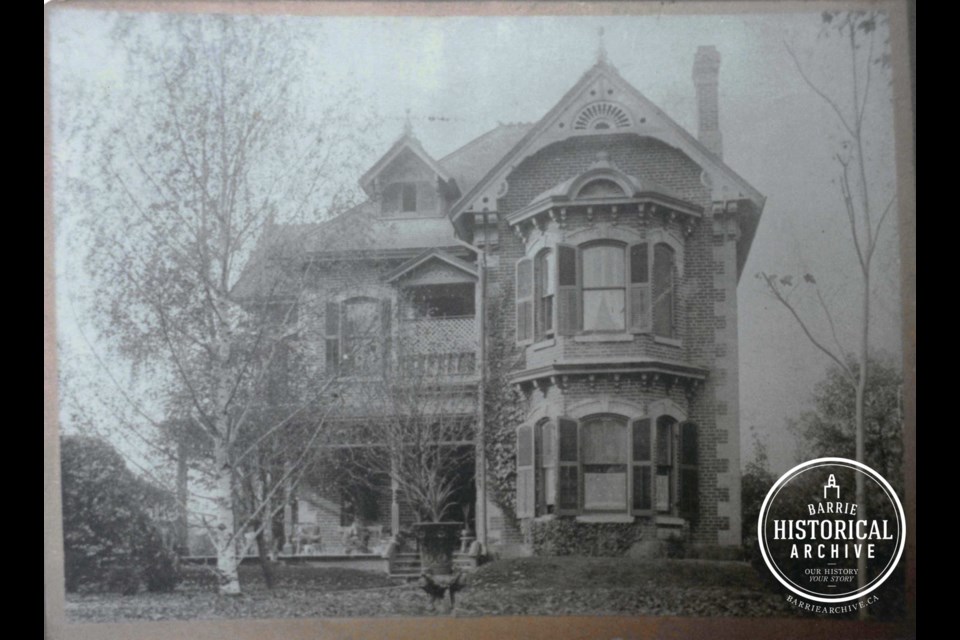This ongoing series from Barrie Historical Archive curator Deb Exel shows old photos from the collection and one from the present day, as well as the story behind them.
Maplehurst – 72 High St.
This home has to be one of the most – if not the most – well-known, much-admired and definitely revered and storied historic homes in Barrie.
Nathaniel Dyment, a family name that many are familiar with, built this extremely fashionable home for his son Simon and daughter-in-law Annie in 1883.
In time, multiple Dyment homes would stand on High Street and all of them quite stately: 74 High St., home of Harold Dyment (Simon’s son) and his wife Agnes Campbell; Rowanhurst, Nathaniel Sr.’s home, and John Dyment’s home at the corner of High and Elizabeth streets.
But none of the other Dyment homes were nearly as impressive as the majestic Maplehurst.
As a one of Barrie’s most prominent families, the Dyment home likely saw many social events and high times. My own grandparents, in fact, had attended parties in the glamorous Dyment home. And this weekend, more recent generations of our family find themselves in the elegant Dyment mansion for a small but very special occasion.
Legendary Barrie storyteller Mary Harris provides a tale of parties and celebrations at Maplehurst. I hope you enjoy her story below:
Shine Like a Dyment
If you had the misfortune of missing out on the lumber boom of the 1870s, and you neglected to invest in the Barrie Carriage Company or in fast racehorses, you still have a chance to shine like a Dyment. It’s not too late.
The patriarch of that family, Nathaniel Dyment, did most of the groundwork. As a youth, this English-born lad bought and sold a single tree for one dollar and grew a massive lumber empire from that initial deal. Twenty years later, with several mills in multiple towns, Mr. Dyment came to Barrie.
Nathaniel and his wife, Annie McRae, raised a family of eight, which included five sons. The four sons who survived to adulthood — Simon, Albert, William, and John — were nicely set up in business by their father.
Simon was 20 years old and well on his way to being a lumber king in his own right when he married Annie White in Northumberland County. The young couple had just returned to Barrie, with infant son, Harold, in tow, when Nathaniel decided that this pair deserved a fine home befitting of timber royalty, just around the corner from his own grand house.
Maplehurst, at 72 High St., was built in 1883 within sight of Nathaniel Dyment’s home, Rowanhurst, at the northeast corner of High and Elizabeth streets. Into these comfortable surroundings, five more children were born — Irene, Nathaniel, Walter, William, and Clarence.
When not running his business, Simon had plenty of other things to do. He sat on several utility boards and experimented with the manufacturing of automobiles in Barrie, but what he really enjoyed was the sporting life. His Brookdale Farm racehorses were near-constant winners and they inspired the name of the team in another sport that he loved: the Barrie Colts of hockey.
Mrs. Simon Dyment enjoyed entertaining in a house that was made for just that. Very likely, the occasion that was given her closest attention was the 1906 wedding reception for her only daughter, Irene, as she married banker Charles Gregory.
“A reception and elaborate dejeuner at Maplehurst followed the ceremony. Mr. and Mrs. Gregory receiving in the drawing room beneath a bridal bell which overhung an alcove of palms. The house decorations were yellow chrysanthemums, smilax and palms. Soft music was played by Marsicano’s Orchestra. In the centre of the bride’s table was the handsome wedding cake standing on a centre of yellow chiffon over satin, with bowls of chrysanthemums on both sides, while yellow ribbons entwined with smilax were hung from the ceiling to the four corners of the table, the whole presenting a most charming effect.”
Within a few years, the good times rolled a little less frequently at Maplehurst. Simon Dyment had overextended himself financially.
Mrs. Dyment passed away in 1927 and Simon remarried the next year. He and his new bride moved to Toronto and his son, Howard Dyment, was the next lord of the manor at Maplehurst. Once Simon died in 1933, his outstanding debts were called in and it looked for a time as if all the Dyment-owned properties along High Street might be lost to a sheriff’s sale.
Somehow, the family pooled together and held strong, although Rowanhurst was sold. In those dark days, Mrs. Howard Dyment, a resourceful woman, saw that Maplehurst could be a money-maker of some sort. At first, she advertised freshly baked cakes, cookies, fancy sandwiches and candy from her well-appointed kitchen.
Then, she progressed to hosting soirees at her home, which landed her in some trouble when the place was raided and a large quantity of liquor discovered. Mrs. Dyment was fined $337.
If the first instance was an innocent mistake, Mrs. Dyment had a difficult time explaining her actions two years later when she was raided again. Nevertheless, she persevered, obtained the proper licences and operated a very well-respected party venue for many years afterwards.
No doubt, there will be plenty of people in Barrie who remember attending beautifully catered Christmas and New Year’s Eve parties, wedding receptions, retirements, and corporate occasions at Maplehurst over the years.
The High Street home left Dyment hands in 1967, but continues to shine brightly.
Although the original red and buff brickwork has been painted, so much of Maplehurst’s outstanding detail still remains… the beautiful ornament capping the stacked bow windows, the sunburst decoration on the gables, the striking bracketing at the eaves and the decorative bargeboard.
Inside, the gracious staircase, fireplaces and many other architectural features are still gloriously intact.
Maplehurst is also designated under the Ontario Heritage Act for its architectural and historical significance.



